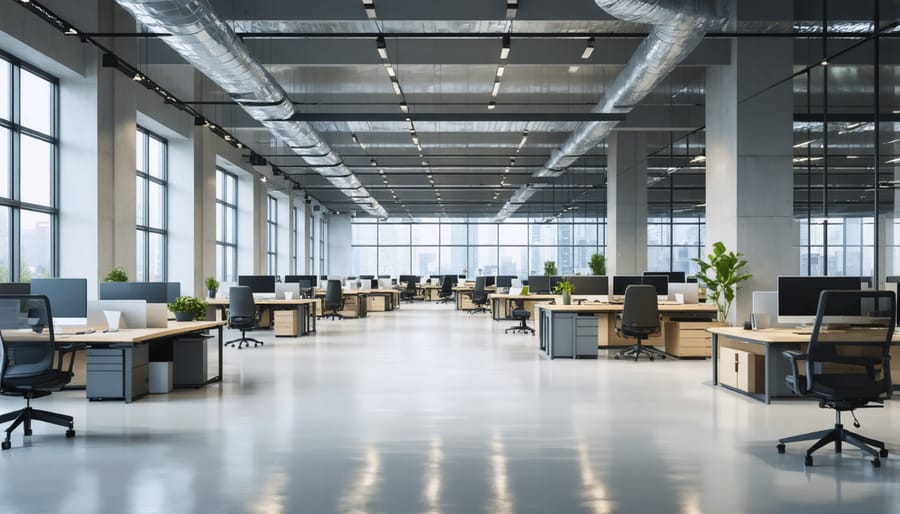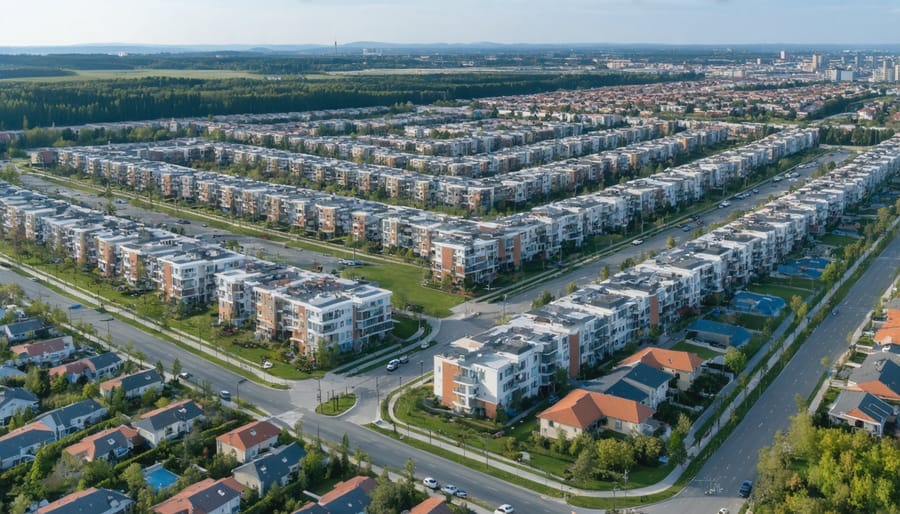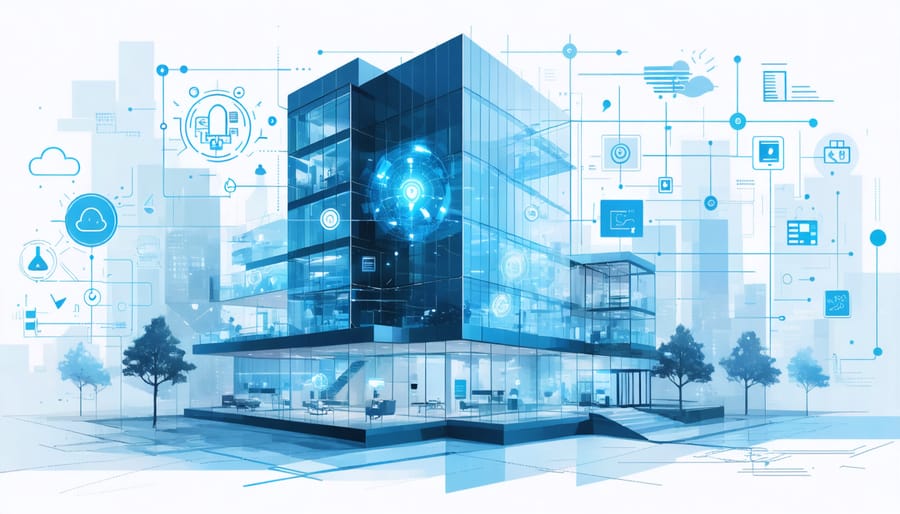The US real estate market stands at a pivotal crossroads, with construction industry professionals navigating unprecedented challenges and opportunities in 2024. Current housing market trends reveal a complex landscape shaped by rising interest rates, shifting demographic patterns, and evolving building technologies. Construction firms face a transformed market where traditional residential development strategies require significant recalibration, particularly in high-growth metropolitan areas where demand patterns have fundamentally shifted.
Industry data indicates a 15% surge in multi-family construction projects across major urban centers, while single-family home developments in suburban areas experience varying degrees of market resistance. This bifurcation demands strategic positioning from construction professionals, with successful firms increasingly leveraging data analytics and sustainable building practices to maintain competitive advantage.
For construction industry leaders, understanding these market dynamics isn’t merely academic—it directly impacts project pipelines, resource allocation, and long-term strategic planning. The following analysis examines critical market indicators, regional variations, and emerging opportunities that will define construction industry success in the coming years.
Commercial Real Estate Transformation
Office Space Revolution
The hybrid work revolution has fundamentally transformed office space requirements, creating a significant shift in construction and retrofitting demands across the U.S. real estate market. According to recent industry data, approximately 74% of companies are adopting hybrid work models, directly impacting office space utilization and design requirements.
Modern office retrofitting projects now prioritize flexible workspace configurations, enhanced technological infrastructure, and improved ventilation systems. Construction professionals are seeing increased demand for modular walls, collaborative zones, and digital integration capabilities. Recent projects demonstrate a 40% increase in technology-enabled meeting spaces and a 30% reduction in traditional cubicle layouts.
Building owners are investing heavily in smart building technologies and sustainable upgrades to attract and retain tenants. Energy-efficient systems, touchless technologies, and advanced air filtration have become standard requirements rather than luxury additions. A notable trend is the conversion of traditional office spaces into mixed-use environments, combining work areas with amenity spaces and wellness facilities.
Market analysis indicates that while new office construction has decreased by 25% compared to pre-pandemic levels, renovation and retrofitting projects have increased by 35%. This shift presents significant opportunities for construction firms specializing in adaptive reuse and building modernization. Urban centers are particularly experiencing high demand for office space transformations, with an emphasis on creating environments that support both in-person collaboration and remote work integration.

Industrial Property Boom
The industrial property sector continues to experience unprecedented growth, driven primarily by the exponential rise in e-commerce and the increasing demand for sophisticated logistics facilities. Recent market data indicates a 45% year-over-year increase in warehouse construction starts, with major metropolitan areas leading this expansion.
Developers are particularly focused on last-mile delivery facilities and multi-story warehouse configurations in urban centers. These properties feature advanced automation systems, enhanced loading dock capabilities, and sustainable design elements to meet modern distribution requirements. Average clear heights have increased from 32 feet to 36-40 feet to accommodate automated storage and retrieval systems.
Investment in cold storage facilities has notably accelerated, with a 23% increase in development pipeline compared to previous years. This surge reflects the growing demand for temperature-controlled spaces driven by online grocery delivery services and pharmaceutical storage requirements.
Key markets such as Dallas-Fort Worth, Chicago, and the Inland Empire continue to lead in industrial space absorption, with vacancy rates reaching historic lows below 4%. Rental rates have appreciated by an average of 15% annually in prime locations, reflecting robust demand from both traditional industrial users and e-commerce operators.
Construction costs for industrial properties have risen approximately 18% due to material price escalation and labor shortages. However, strong tenant demand and compressed cap rates continue to justify new development, with pre-leasing rates exceeding 65% for speculative projects in major markets.

Residential Construction Dynamics
Multi-Family Development Surge
The multi-family development sector is experiencing unprecedented growth, with construction starts reaching their highest levels since the 1980s. Recent data from the U.S. Census Bureau indicates a 28% year-over-year increase in multi-family building permits, reflecting strong demand for rental properties and urban living spaces.
Major metropolitan areas are leading this surge, with cities like Austin, Nashville, and Phoenix witnessing particularly robust development activity. These markets are characterized by strong population growth and employment opportunities, driving demand for both luxury and workforce housing options.
Construction firms are adapting their strategies to meet evolving market demands, incorporating flexible design elements and enhanced amenities. Modern multi-family developments increasingly feature co-working spaces, package delivery rooms, and outdoor entertainment areas – amenities that have become essential in post-pandemic planning.
Financing trends show continued confidence in the multi-family sector, with institutional investors maintaining strong appetites for these developments. Construction loans for multi-family projects have seen more favorable terms compared to other commercial real estate segments, though lenders are exercising increased due diligence in underwriting.
Industry experts project this momentum to continue through 2024, albeit with regional variations. Markets with strong job growth and affordability challenges are expected to see sustained demand for multi-family housing. However, developers must navigate challenges including rising construction costs, labor shortages, and increasingly complex municipal regulations.
The trend toward sustainable building practices is also reshaping multi-family development, with many projects incorporating energy-efficient systems and environmentally conscious design elements to meet both regulatory requirements and tenant preferences.
Single-Family Home Evolution
The single-family home landscape has undergone significant transformation in recent years, driven by changing consumer preferences, technological advancements, and rising construction costs. Modern homebuyers are demanding larger floor plans, averaging 2,500 square feet compared to 1,725 square feet in 1980, with dedicated spaces for remote work and multi-generational living arrangements.
Energy efficiency has become a paramount consideration, with builders incorporating advanced insulation systems, smart HVAC controls, and solar-ready designs as standard features. Construction specifications now routinely include provisions for EV charging infrastructure and whole-house automation systems, reflecting the growing integration of technology in residential spaces.
Architectural designs are evolving to emphasize indoor-outdoor living spaces, with larger windows, sliding glass walls, and covered outdoor living areas becoming standard elements. Building envelope specifications have become more stringent, with enhanced requirements for moisture management, air barriers, and thermal performance.
Material selections are shifting toward sustainable and resilient options, including engineered wood products, high-performance windows, and weather-resistant building materials. Construction methods are increasingly incorporating prefabricated components and modular elements to improve efficiency and reduce on-site labor requirements.
Regional variations in building codes and climate considerations continue to influence construction specifications, particularly in areas prone to natural disasters. This has led to the widespread adoption of impact-resistant materials, enhanced structural requirements, and region-specific energy performance standards, fundamentally reshaping how single-family homes are built across different markets.
Technology and Sustainability Integration
Smart Building Requirements
Modern real estate developments increasingly prioritize smart building technologies as essential components rather than luxury add-ons. Industry data indicates that 85% of new commercial construction projects now incorporate integrated building management systems (BMS) as standard features.
Key technological requirements include advanced HVAC automation, occupancy-based lighting controls, and IoT-enabled security systems. Building owners and developers are particularly focused on energy management solutions, with smart meters and real-time consumption monitoring becoming standard specifications in new construction projects.
According to recent industry surveys, tenants now expect wireless infrastructure capable of supporting 5G connectivity, automated access control systems, and smart parking solutions. The demand for touchless technologies has accelerated, driving the integration of mobile-based access systems and voice-activated controls throughout buildings.
Data infrastructure requirements have also evolved significantly. New construction projects must incorporate robust networking capabilities, including dedicated server rooms, multiple telecommunications entry points, and distributed antenna systems (DAS) for enhanced cellular coverage.
Energy efficiency standards are becoming more stringent, requiring smart building systems that can automatically optimize resource usage. This includes demand-response capabilities, predictive maintenance systems, and integration with renewable energy sources.
Construction professionals must now plan for future technological adaptability, incorporating flexible infrastructure that can accommodate emerging technologies. This forward-thinking approach includes provisions for expanding IoT device networks, enhanced cybersecurity measures, and scalable building automation systems.

Green Building Standards
Green building standards are rapidly transforming the US real estate landscape, with LEED certification becoming increasingly mandatory in major metropolitan areas. Recent market analysis indicates that 65% of new commercial construction projects now incorporate sustainability requirements, reflecting broader sustainable building design trends across the industry.
The International Building Code (IBC) has introduced stricter energy efficiency requirements, compelling developers to adopt advanced insulation methods, energy-efficient HVAC systems, and renewable energy integration. California’s Title 24 energy code, which many states are now emulating, mandates solar panels on new residential construction and sets ambitious targets for building performance metrics.
Construction methods are evolving to meet these standards, with prefabricated components and modular construction gaining prominence due to their reduced environmental impact and waste generation. Building envelope technologies, including dynamic glass and advanced air barrier systems, are becoming standard specifications rather than premium upgrades.
Material selection criteria now heavily emphasize Environmental Product Declarations (EPDs) and embodied carbon calculations. Construction professionals report a 40% increase in specifications requiring low-carbon concrete alternatives and FSC-certified wood products. These requirements are driving innovation in building materials and creating new opportunities for manufacturers focused on sustainable solutions.
Water conservation features and indoor air quality management systems have become non-negotiable elements in new construction, particularly in drought-prone regions and urban centers. This shift is fundamentally altering project planning, budgeting, and execution strategies across the industry.
Regional Market Variations
The U.S. real estate market exhibits significant regional variations in construction demand, driven by distinct economic, demographic, and regulatory factors across different geographical areas. In the Northeast, demand centers primarily on urban redevelopment and adaptive reuse projects, with particular emphasis on mixed-use developments in metropolitan areas like Boston and New York City. These markets demonstrate strong preferences for sustainable building practices and smart building technologies, influencing construction specifications and project costs.
The Southeast continues to experience robust growth in residential and commercial construction, particularly in Florida, Georgia, and the Carolinas. Population migration patterns and business relocations have created sustained demand for new construction across all sectors. Implementing effective market analysis strategies is crucial for success in these rapidly evolving markets.
Western states, notably California, Colorado, and Washington, show strong demand for tech-oriented commercial spaces and sustainable residential developments. These markets face unique challenges related to land availability and stringent environmental regulations, often resulting in higher construction costs and longer project timelines.
The Midwest presents a more balanced market picture, with steady demand for industrial facilities and logistics centers, particularly in states like Illinois, Michigan, and Ohio. These markets benefit from lower land costs and less restrictive regulations, though they face challenges related to workforce availability and seasonal construction limitations.
Southwest markets, including Texas and Arizona, continue to lead in new residential construction volume, driven by population growth and business-friendly environments. These regions demonstrate particular strength in master-planned communities and industrial development, though water availability concerns increasingly influence construction planning and design requirements.
Mountain states show emerging opportunities in resort development and remote work-oriented communities, reflecting changing lifestyle preferences post-pandemic. These markets require specialized construction approaches to address climate challenges and environmental considerations.
Understanding these regional variations is essential for construction professionals planning market entry strategies or expanding existing operations. Each region’s unique characteristics demand tailored approaches to project planning, resource allocation, and risk management.
As we navigate through these dynamic market conditions, construction industry professionals must adopt strategic approaches to capitalize on emerging opportunities while mitigating risks. The data clearly indicates a shift toward suburban development and adaptive reuse projects, suggesting the need for versatile construction capabilities and expertise in renovation work.
To remain competitive in this evolving landscape, consider implementing these key action items: First, invest in modular construction technologies and sustainable building practices, as these continue to drive both cost efficiency and market demand. Second, develop partnerships with PropTech companies to integrate smart building solutions into your project portfolio, meeting the growing expectations for connected spaces.
Market analysis suggests focusing on mixed-use developments and affordable housing projects, particularly in secondary markets experiencing population growth. These segments show promising stability even during market fluctuations. Additionally, healthcare facility construction and data center development remain robust sectors worthy of strategic positioning.
For immediate implementation, prioritize updating your supply chain management systems to address ongoing material cost volatility. Consider establishing regional material warehousing capabilities and strengthening relationships with local suppliers. Also, invest in workforce development programs to address the persistent labor shortage while building expertise in emerging construction technologies.
Remember that market conditions vary significantly by region, so maintain flexibility in your operational approach and resource allocation. Success in the current market requires balancing innovation with proven construction methodologies while maintaining strong risk management practices.

